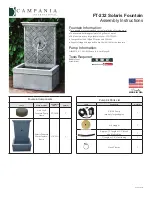
beam where the rafters are to intersect with the beam, making
sure that the location corresponds with the wall brackets.
Fasten through the connection bracket holes into the beam
using 2 10x16 self drilling screws per bracket (see Figure 2).
Push in beam endcap if required.
ASSEMBLE RAFTER ON THE GROUND
Check the beam orientation against the pergola end, making
sure that the laps of each beam are on the same side. Ensuring
that the double thickness portion is at the top, slide the beam- to-
beam connection sleeve over the end of the beam. Line the end
of the beam up with the notch of the sleeve and fasten using 5
10x16 coloured self drilling screws through the holes provided.
Slide the pergola end into the connection sleeve, aligning it with
the other side of the notch and screw into place (see Figure 3.)
Pergola endcaps simply snap into place.
FIXING THE END RAFTER
Select an end rafter, lift it into the wall bracket, (as described in
Figure 4) positioning it between the flanges so that the curved
top of the flanges locate against the top flute of the beam.
Support the other end of the rafter on an adjustable construction
prop, and screw into position using 4 10x16 coloured self drilling
screws through the holes in the wall bracket (see Figure 4).
POSITIONING THE BEAM
Supporting the front beam on construction props, slide the end
rafter connection sleeve over the connection bracket on the
beam, fastening in position with 2 10x16 coloured self drilling
screws through the holes in the sleeve (see Figure 5).
FIXING THE REMAINING RAFTERS
Fix the other end rafter by lifting it over the front beam then
sliding it back into the flanges of the wall bracket, screwing it into
position. Lift the rafter over the connection bracket and screw
through the holes provided. Attach the remaining rafters
following this method.
ATTACHING COLUMNS
Dig column holes to a minimum of 300mm long x 300mm wide x
450mm deep. Place a half brick in the bottom of the hole to
minimise settlement. Measure the distance from the bottom of
the beam to the top of the brick, and cut the column to length.
Slide the top of the column over the post bracket until it is flush
with the under side of the beam. Mark and drill an 11mm
diameter hole on the two plain faces of the column 30mm below
the top of the column. Fasten with the M10 x 75mm bolt and
selflocking nut supplied and push post caps into place.
FRAMEWORK CHECK
Check that all posts are vertical and beams and rafters are
square and level. Check the basic framework for squareness by
ensuring the diagonal measurements are the same (see Figure
6). ie. A, C and B, D are the same distance. Concrete the posts
into position.
PURLIN CONNECTIONS
If further stability of rafters is required, or shade cloth is
proposed, purlins can be screwed to rafters every 600mm to
1200mm. It is recommended that any shade cloth is fitted
between the top of the rafters and the bottom of the purlins for a
superior, tidy finish. Purlin endcaps simply push into place.
These should be removed periodically and any debris washed
out. Do not seal.
TRACK INSTALLATION
Fasten with 4 10x16 coloured
selfdrilling screws
Pivot up
Locate beam
on bracket groove
Slide in
flush
Figure 4
Wall
bracket
Fascia beam
Connection
bracket
End rafter
beam
Connection
sleeve
Fasten with 2
10x16 coloured
self drilling srews
Pergola end
Construction
prop
Post
bracket
Construction
prop
Figure 5
Beam endcap
Connection
bracket
Fasten with 2 10x16 self drilling screws
Fascia beam
Fasten with countersunk
self drilling screws
(two on each side)
Post cap
Figure 2
Post bracket
A
B
C
D
Figure 6
Connection
sleeve
Rafter beam
Pergola end
Pergola Endcap
Fasten with 5
10x16 coloured
self drilling screws
Ensure that rafter
beam and pergola end
are correctly orientated,
with double thickness
portion at the top
Figure 3
Figure 7
Purlin
endcap
Rafter
beam
Shadecloth
Purlin
Fasten with 2
10x16 self
drilling screws





















